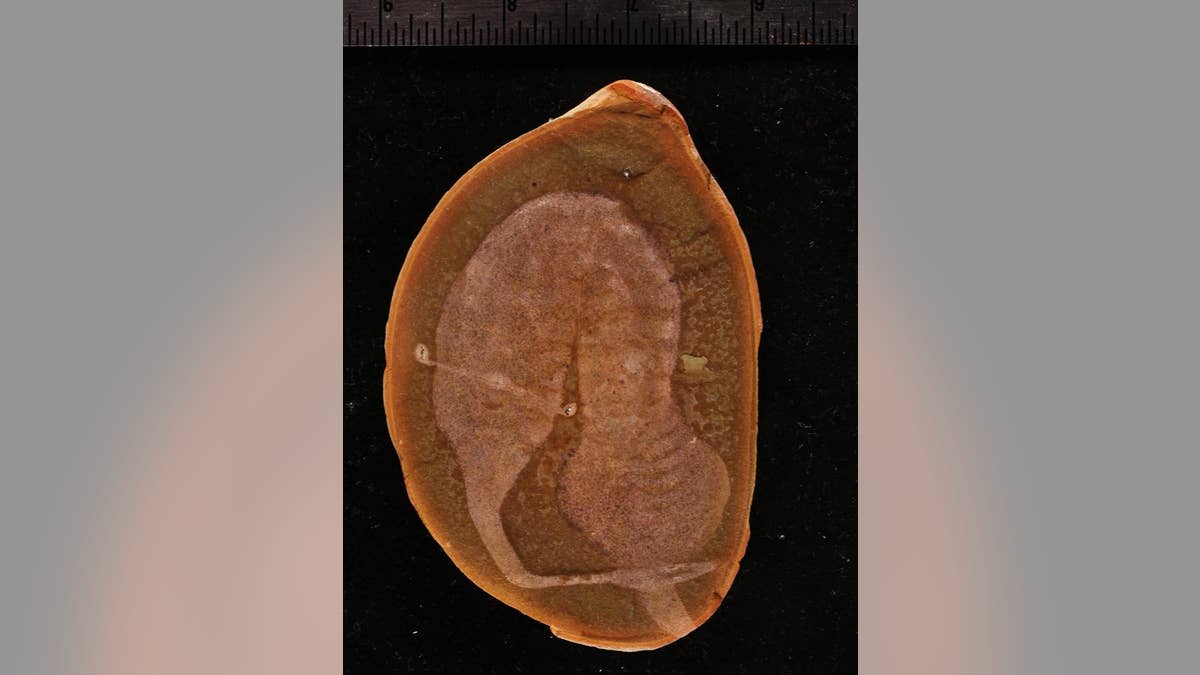
This undated photo provided by The Field Museum in Chicago shows a fossil of a Tully monster. The Tully monster, an oddly configured sea creature with teeth at the end of a narrow, trunk-like extension of its head and eyes that perch on either side of a long, rigid bar, has finally been identified. Fossil hunters have been finding samples of Illinois' state fossil in the Mazon Creek area for decades but no one has ever been able to say exactly what a Tully monster is. That changes Thursday, March 17, 2016, with the publication of a paper in the journal Nature. (Paul Mayer/The Field Museum via AP) (The Associated Press)
CHAMPAIGN, Ill. – For decades, fossil hunters combing the soil near a creek in north-central Illinois have been rewarded with the preserved remnants of a prehistoric creature, its wide-set eyes on stalks and a long, arm-like appendage extending from below them with a pincher-like mouth.
There was no doubt that the Tully monster, Illinois' official state fossil, was "very, very bizarre," said Scott Lidgard, a paleontologist at Chicago's Field Museum. But no one could say exactly what the soft-bodied creature was.
That changed Wednesday with a paper published in the journal Nature: A group of researchers, Lidgard included, concluded the Tully monster had a precursor to a backbone, making it a vertebrate, or primitive fish.
The origin of vertebrates is still an open question, he said, and there aren't many good examples of preserved, soft-bodied fishes. It's also personally important for Lidgard, who's long been charged with the museum's collection of 1,800 Tully monster fossils, the largest in the world.
"I'm pretty excited because I've had to live with this guy, something I wish I knew what it was, for my 32 years here," he said. "And it's been a puzzle."
About 300 million years ago, the Mazon Creek area, about 50 miles southwest of downtown Chicago, was a warm coastal marsh near the equator, along a long-gone sea. This was before the dinosaurs; Tyrannosaurus rex didn't come about until roughly 67 million years ago.
The abundant plant life eventually became coal, and eons later, strip mining dug up piles of earth and shale — and fossilized prehistoric life. Paleontologists consider the area a treasure because of plant and animal life that was, for reasons not fully known, set in stone quickly enough before decay could set in.
An amateur paleontologist named Francis Tully unearthed the first Tully monster in 1958. Thousands of other examples have since been found by fossil hunters combing the area, much of it now set aside as Mazonia-Braidwood State Fish and Wildlife Area.
Mining faded in the 1970s, and, after decades of fossil hunting, the area does not yield quite as many specimens as it used to, said Colleen Schmidt, an office associate at the state fish and wildlife area.
But those who know where to look — "they do have their (secret) spots," Schmidt said — can still find plenty. They leave with oblong nodules of rock, some of which, when broken open, contain fossils; often it's plant life, like prehistoric ferns that are hard to imagine on Illinois' prairie.
The Tully monster fossils show a creature that swam the shallows of that ancient sea and ranged from a few inches long to roughly a foot. There are traces of other, more-familiar animals, Lidgard said, especially the odd mouth and its teeth, known as stylets, that share some characteristics with squids and lampreys. The eye stalks are similar to some snails.
But the team of researchers from the museum, Argonne National Laboratory, Yale University and elsewhere focused on some of the fossils' curious raised areas. Those areas were once believed to be remnants of the animal's guts, but that kind of soft tissue would have been pressed flat as it was fossilized, so these areas must have been something harder, more resilient, they thought.
"It has a cartilage skeletal system," Lidgard said the group concluded. "It runs along the midline. Beneath it is the nerve cord ... Sort of a precursor to a spine."
Even with the discovery, the Tully monster remains in many ways an enigma.
That strange mouth, extended away from its body, may have helped it as a predator, Lidgard said, or maybe it scavenged for food. The wide-set eyes may have given it a greater field of vision for hunting, but no one knows for sure.
And Mazon Creek continues to offer more mysteries.
"There's an animal called the H animal," named for its odd, H-shaped body, Lingard said. "We don't know what it is."
___
Online:
Nature: www.nature.com/index.html
Field Museum, www.fieldmuseum.org/
Mazonia-Braidwood State Fish and Wildlife Area: www.dnr.illinois.gov/Parks/Pages/Mazonia-Braidwood.aspx
___
Follow David Mercer on Twitter at https://www.twitter.com/davidmercerAP
